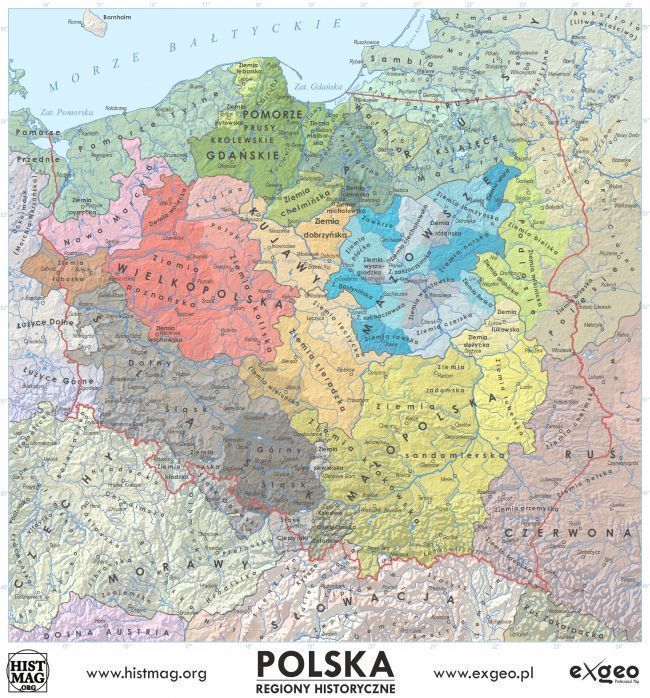Post by Bonobo on Mar 21, 2020 14:24:09 GMT 1
 ]
]en.wikipedia.org/wiki/Polish_historical_regions
Polish historic regions are regions that were related to a former Polish state, or are within present-day Poland without being identified in its administrative division.
There are several historic and cultural regions in Poland that are called ethnographic regions. Their exact borders cannot be drawn, as the regions are not official political or administrative units. They are delimited by culture, such as country traditions, traditional lifestyle, songs, tales, etc. To some extent, the regions correspond to the zones of Polish language dialects. The correspondence, however, is by no means strict.
Modern regions of the current Polish state
Within Poland's modern borders are the following historic regions:
Greater Poland (Polish: Wielkopolska, Latin: Polonia Maior)
Lesser Poland (Polish: Małopolska, Latin: Polonia Minor)
Red Ruthenia (Polish: Ruś Czerwona, Latin: Ruthenia Rubra, only partially in modern Poland)
Prussia (Polish: Prusy, German: Preußen, Latin: Borussia, only partially in modern Poland, also a German historical region)
Lithuania Minor (Polish: Litwa Mniejsza; (Lithuanian: Mažoji Lietuva; German: Kleinlitauen; Russian: Máлая Литвá) or Prussian Lithuania (Polish: Litwa Pruska); (Lithuanian: Prūsų Lietuva, German: Preußisch-Litauen) only part in Poland, also a Lithuanian land and German historical region now mostly within the Kaliningrad Oblast of Russia
Masovia (Polish: Mazowsze, Latin: Mazovia)
Kuyavia (Polish: Kujawy, Latin: Cuiavia)
Lusatia (Polish: Łużyce, German: Lausitz, Latin: Lusatia, only partially in modern Poland, also a German historical region)
Podlasie (Polish: Podlasie, Polish: Podlasze, Latin: Podlachia)
Southern Podlasie [pl] (Polish: Podlasie Południowe)
Pomerania (Polish: Pomorze, German: Pommern, Latin: Pomerania, only partially in modern Poland, also a German historical region)
Pomerelia (Polish: Pomorze Gdańskie, German: Pommerellen, Latin: Pomerania)
Silesia (Polish: Śląsk, Silesian: Ślůnsk, German: Schlesien, Czech: Slezsko, Latin: Silesia), only part in Poland, also a Czech land and German historical region
Historic regions of former Polish states outside current Polish borders
Outside Poland are several historic regions which were once part of the Grand Duchy of Lithuania, a confederal part of the Polish-Lithuanian Commonwealth, or the Second Polish Republic. While these regions are important for Polish history, calling them Polish is controversial, as they were never predominantly populated by ethnic Poles and now lie beyond the borders of Poland. They are:
Aukštaitija, Lithuania (Polish: Auksztota)
Black Ruthenia (Polish: Ruś Czarna, Latin: Ruthenia Nigra)
Smolensk Land (Polish: Ziemia Smoleńska, Latin: Terra Smolensciae)
Livonia (Polish: Inflanty, Latin: Livonia)
Podolia (Polish: Podole, Latin: Podolia)
Samogitia (Polish: Żmudź, Latin: Samogitia)
Ukraine (Polish: Ukraina, Latin: Ucraina)
Volhynia (Polish: Wołyń, Latin: Volhynia)
White Ruthenia, Belarus (Polish: Ruś Biała, Latin: Ruthenia Alba)
Historic regions inside the borders of the current Polish state
Modern Poland is rich in history, including major border and population shifts. It comprises many historic regions:
Chelmno Land (Polish: Ziemia Chełmińska, German: Culmerland, Latin: Terra Culmensis, also a German historical region)
East Prussia (Polish: Prusy Wschodnie, German: Ostpreußen, see Prussia, also a German historical region, only partially in modern Poland)
Farther Pomerania (Polish: Pomorze Zachodnie, German: Hinterpommern, see Pomerania, also a German historical region)
Kashubia (Polish: Kaszuby, Kashubian: Kaszëbë, German: Kaschubien, Latin: Cassubia)
Lower Lusatia (Polish: Łużyce Dolne,German: Niederlausitz, Latin: Lusatia Inferioris, also a German historical region)
Lower Silesia (Polish: Dolny Śląsk, German: Niederschlesien, Latin: Silesia Inferioris, also a German historical region)
Lubusz Land (Polish: Ziemia Lubuska, only partially in modern Poland - during the high Middle Ages absorbed into the region of Neumarkt)
Mazovia (Polish: Mazowsze, Masovian: Mazofse, Latin: Mazovia)
Neumark (Polish: Nowa Marchia, German: Neumark, also a German historical region)
Polesia (Polish: Polesie, Latin: Polesia)
Upper Lusatia (Polish: Łużyce Górne, German: Oberlausitz, Latin: Lusatia Superioris, also a German historical region)
Upper Silesia (Polish: Górny Śląsk, German: Oberschlesien, Latin: Silesia Superioris, also a German historical region)
Warmia (Polish: Warmia, German: Ermland, Latin: Varmia, also a German historical region)
West Prussia (Polish: Prusy Zachodnie, German: Westpreußen, see Pomerelia, also a German historical region)
Western Pomerania (Polish: Pomorze Zachodmie, German: Vorpommern, see Pomerania, also a German historical region, only partially in modern Poland)







